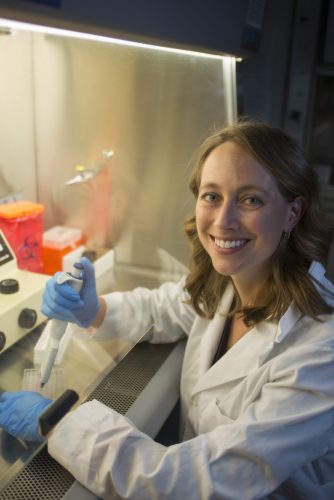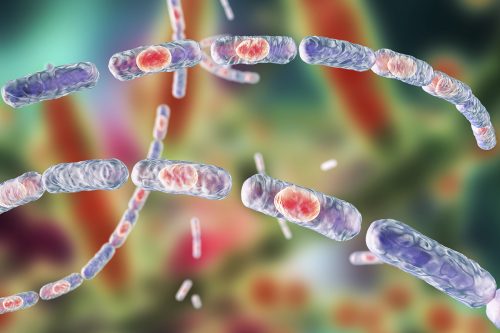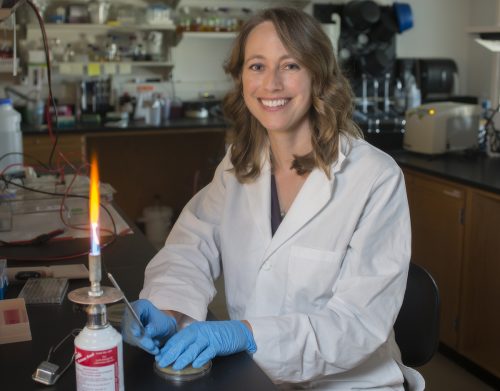Stopping Anthrax with Antibiotics
An enzyme may be key to stopping tough bacterial infections.
Stopping Anthrax with Antibiotics
An enzyme may be key to stopping tough bacterial infections.
Anthrax has an Achilles’ heel — one that could help researchers create a new antibiotic to defeat the deadly bacteria as well as more common infections.
Shauna McGillivray, associate professor of biology, figured out how to render the bacteria harmless in mammals by subverting one of the key enzymes that anthrax uses to create disease.

Shauna McGillivray, associate professor of biology, studies the deadly bacteria anthrax and believes it has an Achilles’ heel — one that could help researchers create a new antibiotic to defeat it as well as more common infections. Photo by Robert W. Hart
That key is called ClpXP (clip-ex-P). It’s a protease, or an enzyme, the job of which is to take apart unwanted proteins. ClpXP is present in many bacteria, including anthrax and methicillin-resistant Staphlyoccucus aureus, or MRSA.
“The enzyme functions like a garbage disposal in the cell,” McGillivray said. “If you get rid of it, the cell doesn’t have a way to get rid of these proteins. … They can just kind of gunk up the cell.” A cell that can’t keep its own inner workings free of frayed, used-up protein machinery can stop functioning and die.
Several years ago, McGillivray found that by mutating one of the bacterial genes that encodes ClpXP, she could create a nonvirulent version of anthrax, one easily cleared up by the immune system in mice. Her work at TCU involves a strain of the bacterium that is not harmful. But collaborators at the U.S. Army Medical Research Institute of Infectious Diseases who work with deadly wild-type anthrax found that a mutated ClpXP kneecaps that strain, too.
Knocking out ClpXP also seems to render bacteria highly vulnerable to cathelicidin, a front-line immune protein that mammals make in response to infection. Another protease found in anthrax, one that under normal conditions would exit the cell and destroy cathelicidin, seems to depend on ClpXP.

Anthrax bacteria, computer illustration. Illustration by Getty images © KATERYNA KON/SCIENCE PHOTO LIBRARY
After the discovery, McGillivray teamed with Kenneth Keiler, a professor of biochemistry and molecular biology at Pennsylvania State University, who tested his library of small molecules, consisting of what he described as “chemicals with properties similar to good pharmaceuticals.”
He found one molecule, F2, that incapacitates ClpXP in anthrax and MRSA, making the bacteria vulnerable to the host’s defenses, though exactly how is still unclear, he said.
McGillivray and Keiler co-authored a study showing how a combination of F2 and penicillin made the bacteria more vulnerable — an eye-opener, since MRSA carries a protective mutation that keeps antibiotics, such as penicillin, from binding to a cell wall. Inhibiting ClpXP seems to circumvent the mutation in McGillivray’s experiments, restoring penicillin’s effectiveness.
F2 isn’t suitable for human use, but if researchers can develop an antibiotic that targets ClpXP that is safe, it could help treat a host of troublesome infections. That’s no small thing, since the Centers for Disease Control and Prevention announced in 2013 that the world has entered a post-antibiotic era for some microbes, meaning antibiotic resistance is becoming widespread.

Shauna McGillivray, associate professor of biology, figured out how to render the anthrax harmless in mammals by subverting one of the key proteins anthrax uses to cause disease. Photo by Robert W. Hart
MRSA is one of the worst offenders. First reported as a curiosity in the 1960s — just a few years after the introduction of the antibiotic methicillin — MRSA has in recent decades become a global scourge. In 2011 it killed more than 11,000 people in the United States, the CDC reported.
“One of the things that’s really tough about MRSA is it becomes antibiotic-resistant very, very quickly,” McGillivray said. “So the more tools you have in the toolbox for treating the disease, the better.” (It also couldn’t hurt to have another way to defeat anthrax.)
Giving a potential ClpXP-targeting antibiotic along with penicillin would be a one-two punch similar to the multidrug technique used today to treat AIDS and tuberculosis.
“We’re sort of getting desperate in terms of antibiotic targets, because there’s resistance to so many different existing antibiotics,” Keiler said. “Combination therapy is almost certainly the way of the future for these resistant infections.”

Your comments are welcome
Comments
Related reading:
Campus News: Alma Matters, Research + Discovery
Altering Antibiotics
Student in TCU high school program works on medicines of tomorrow.
Research + Discovery
Personalized Medicine is Tomorrow’s Health Care
Pharmacogenomic testing opens the possibility of a tailored mix of medicines.
Alumni
Saving Premature Babies
A doctor’s invention saves babies in the developing world.